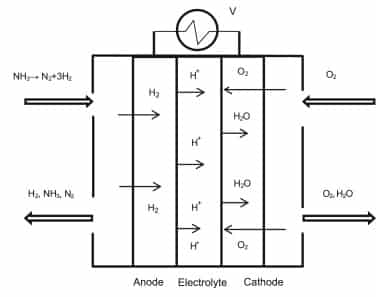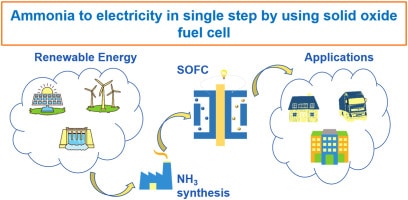Are Ammonia Fuel Cells the Missing Link For Decarbonisation?
Source: CNBC
27 July 2023 – by Eric Koons Comments (0)
As auto manufacturers and consumers shift towards low-carbon alternatives, ammonia fuel cells are gaining traction as a potential transition fuel source.
This transition is being pursued partially due to consumer demand, yet some governments are also setting phase-out dates for fossil fuel engines. For example, in 2019, 30 countries signed a pact to phase out the sale of fossil fuel vehicles by 2040.

This timeline is creating a mad dash to find alternatives capable of replacing combustion engines while also meeting the mounting demands for transport. Ammonia fuel cells have emerged as a potential low-carbon solution to fill this gap.
What Is an Ammonia Fuel Cell?
Ammonia is a colourless gas consisting of nitrogen and hydrogen. One of the simplest and most stable compounds, it is a critical component in industrial and commercial processes. As a result, it has a readily exploitable supply chain. Additionally, the energy to make ammonia can be sourced through renewables – making green ammonia. It has a higher energy density than hydrogen.
This is why many researchers and governments are investing in developing ammonia fuel cell technology. Several types of ammonia fuel cells are in development, yet most rely on the same basic structure.
They consist of two compartments separated by an electrolyte compound and a proton exchange membrane. One compartment has a positive charge (anode), and the other has a negative charge (cathode). An ammonia fuel tank connects to the anode compartment, and an electrical circuit connects to what is using the energy.
How Do Ammonia Fuel Cells Work?
Simply put, they convert the chemical energy stored in ammonia into electrical energy through an electrochemical reaction.

This process starts by feeding ammonia into the anode compartment, which strips the electrons from the ammonia and releases nitrogen gas and protons. The protons move through an electrolyte and proton exchange membrane into the cathode compartment.
In the cathode, the protons combine with oxygen in the air to form water, which releases more electrons. The electrons are captured and directed through a circuit to provide power. The primary byproducts of the reaction are water and nitrogen gas, which are harmless and can enter the environment.
However, solid oxide fuel cells have the highest output but release some nitrogen oxides (NOx). NOx is a potent greenhouse gas. Improved catalytic converters can mitigate these emissions and will be necessary for wide-scale fuel cell adoption.
What Do Ammonia Fuel Cells Power?

Much like hydrogen fuel cells, ammonia fuel cells primarily focus on replacing traditional fossil fuel engines. However, other use cases include being an energy source for rural power grids and emergency services during disasters. Ammonia’s peak power density and manageable storage requirements make it a promising alternative to the existing batteries used in electric vehicles.
What Is the Efficiency of Ammonia Fuel Cells?
Currently, experimental systems produce between 14-1,190 mW cm-2 at peak, making it one of the most energy-efficient forms of power.
Ammonia can potentially be a highly efficient power source for vehicles and energy grids. Unfortunately, no technology is capable of tapping into it without major disadvantages. These challenges include cost, scalability and the creation of NOx.
The Future of Ammonia Fuel Cell Technology
“Ammonia, as a mass-produced, low-cost chemical is an ideal energy vector,” concludes the University of Strathclyde’s Rong Lan and Shanwen Tao. “However, it is not at a stage for commercialisation yet, and further investigation is required.”
Ammonia fuel cells’ potential has made it a research topic for over a decade as scientists and engineers seek to unlock the key to making it a viable option for the low-carbon transition. With added funding and interest in alternatives to lithium-ion batteries, there is growing competition for finding the next big development in energy storage.
Ammonia fuel cells continue to be a topic of interest, but their future needs to be clarified.
Are Ammonia Fuel Cells Viable?
The rapid decarbonisation of our economies is leading to added investment into alternative solutions for transport, energy production and energy storage. Ammonia fuel cells have significant potential as an alternative due to their existing supply chain, ability to harness renewable energy and compound stability.
However, there remains to be a clear path to commercialisation. Other fuel cells such as hydrogen and more established battery systems like lithium-ion currently lead the charge for vehicle decarbonisation. They are already in use or under testing for heavy trucks, aeroplanes and boats.
by Eric Koons
Eric is a passionate environmental advocate that believes renewable energy is a key piece in meeting the world’s growing energy demands. He received an environmental science degree from the University of California and has worked to promote environmentally and socially sustainable practices since. Eric’s expertise extends across the environmental field, yet he maintains a strong focus on renewable energy. His work has been featured by leading environmental organizations, such as World Resources Institute and Hitachi ABB Power Grids.
Read more

